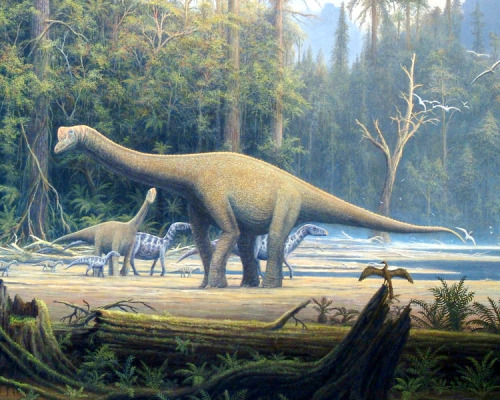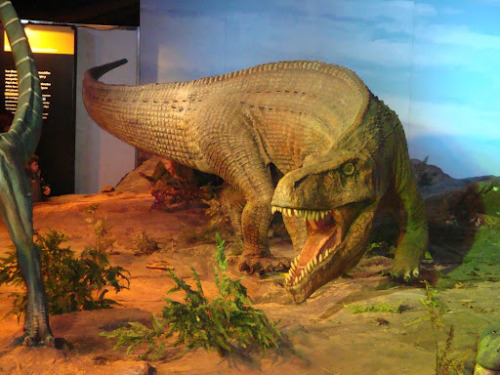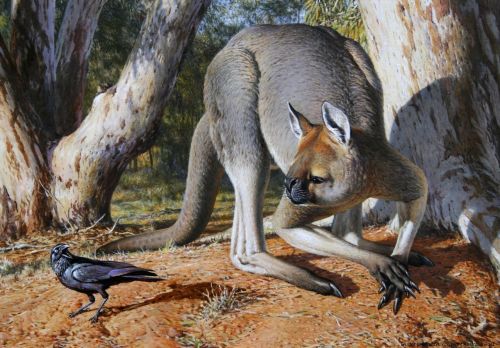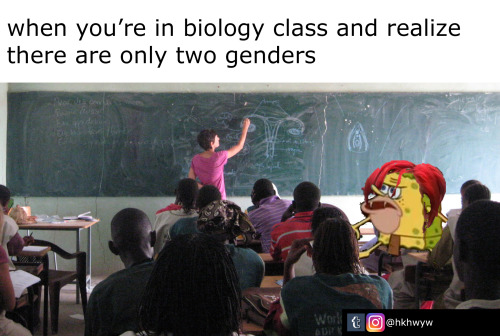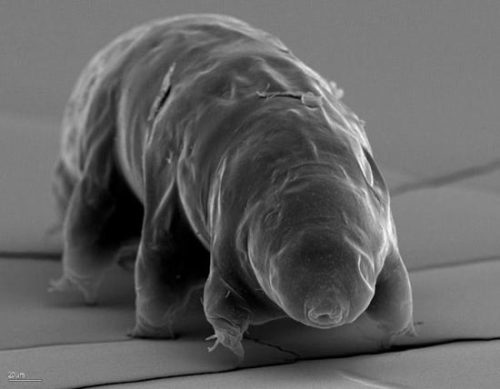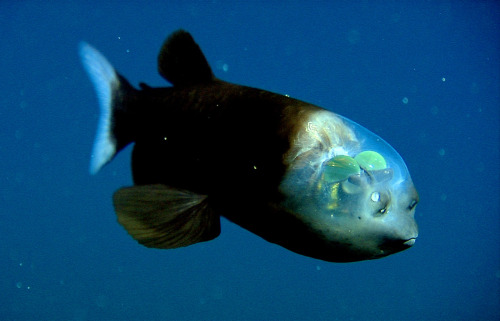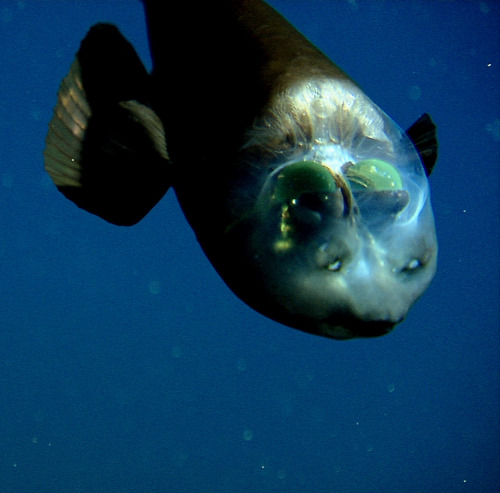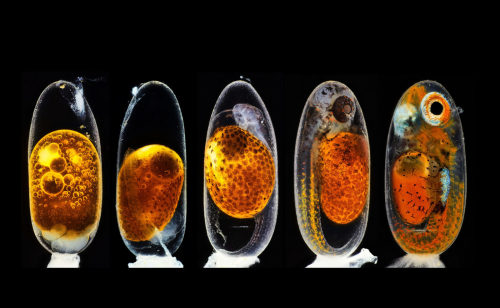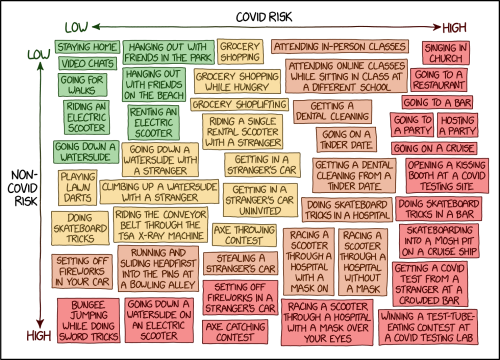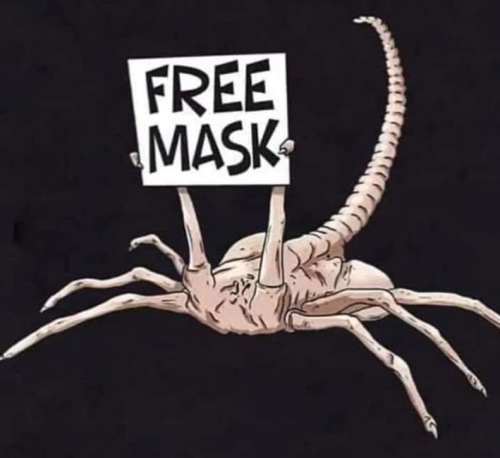#biology
Kronosaurus
Mounted specimen on display at Harvard Museum of Natural History
Reconstruction by Jaime Chirinos
When: Cretaceous (~ 125 - 99 million years ago)
Where: Australia
What:Kronosaurus is an australian plesiosaur. Yes, it is a plesiosaur even though it lacks the long neck that many people associated with the group. Plesiosauria is roughly divided into two groups; Plesiosauroidea - the long necked forms and Pliosauroidea - the short necked forms. Kronosaurus is an example of the latter clade, and shows many of the defining features of this group - such as an enormous head with massive jaws, a short neck, and a relatively short tail- the opposite in many ways of their cousins the plesiosauroids. This australian sea monster was one of the largest of its clade, with estimates of up to 33 feet long (~10 meters). Its teeth reach almost 5 inches (~12 cm ) long in crown length - the part above the gumline. The total tooth would have been over double in size. The large size of its teeth, combined with distinct shape and the lack of clear cutting surfaces also for their easy identification if they are found as isolated material.
The Kronosaurusspecimen seen above was found in on private property in central Queensland, Australia in the 1920s. A crew from Harvard was shown where the specimen was weathering out, and set about excavating the fossil. After years of work, the specimen was boxed up into over 80 crates, weighing in at over 6 tons and shipped to the states, where it was mounted at the Harvard museum. Decades later the original discoverer of the material finally got the see the results of the preparation and mounting of what he termed ‘his dinosaur’ at the age of 93. In life Kronosaurus was a top predator; there are fossils of Elasmosauridae plesiosaurs that show bite wounds that could have come from Kronosaurus! No fish for this animal, it was after much bigger prey, leading to amazing plesiosaur vs plesiosaur encounters. Or so I like to imagine!
Post link
Obdurodon
Skull on display at the American Museum of Natural History, NYC
Reconstruction by Anne Musser
When: Late Oligocene to Miocene (~25 to 12 Million years ago)
Where: Australia
What: Obdurodon is a fossil platypus, as is fairly obvious from a look at its skull. Though upon closer inspection there are some very important differences; Obdurodon had a larger bill than the living platypus and retained teeth as an adult. Modern adult platypus are toothless, shedding all their teeth as juveniles. These teeth are important as they help us place monotremes (platypus and the echidna are the modern representatives) into the mammal family tree. It is now the consensus that marsupials and placentals are more closely related to one another than either is to the monotremes, but there are a great deal of extinct groups of mammals that may fall between therians and the monotremes - such as the multituberculates. Fossils such as Obdurodon which are most assuredly related to modern monotremes, but preserve more primitive features, are critically important for this phylogenetic issue. So then why is it still an issue? All we have of Obdurodon is a skull, despite the full body reconstruction above, and while there are fossils of even older monotremes they are even more scrappy - just isolated teeth or jaw fragments (that still enjoy full body reconstructions…).
How did Obdurodon live compared to the modern platypus? Well, the living form uses its bill in the water to help it sense prey, and as Obdurodon had an even larger bill, it seem likely it also was aquatic, though without a postcranial skeleton it is unknown if it had the same swimming and digging adaptions seen in its extant relatives.
Post link
Europasaurus
Reconstruction by Gerhard Boeggemann
When: Jurassic (~ 156 - 151 million years ago)
Where: Germany
What:Europasaurus is the smallest sauropod known. Now remember I said smallest SAUROPOD known, so we are still looking at an animal that was about 20 feet (~6 meters) long. Keep in mind though, this includes the long neck and tail - taking those out of the picture and the animal’s body length was about 6.5 feet (~ 2 meters). This length, coupled with the shoulder height of Europasaurus ( about 5 feet [~1.5 meters]), gives us a sauropod with a body that was about the size of a modern elephant. There are a number of proposed tiny sauropods out there, but I have selected Europasaurus as it is known from several almost complete skeletons, from juveniles to adults, so we can be sure this is not just a baby sauropod that would have grown much larger. Above I have included a diagram from the original description of Europasaurus rather than a reconstructed mounted skeleton to show you just how much of the skeleton is known. Why is Europasaurus so small? Its our good friend Island Dwarfism back again! The specimens have been found in Germany, on what would have been one of many islands in the area during the late Jurassic, owing to the higher sea levels.
This smallest of all sauropods is in the clade Macranaria within the sauropod family tree. This group actually contains some of the biggest sauropods (and thus dinosuars) ever known! Talk about some size diversity within a group! An adult Europasaurus could have easily walked between the legs of some of its larger cousins. The great range of ages in the recovered specimens of Europasaurushave allowed for detailed study of the microstructure of the bones, revealing how these animals grew. From this study it has been proposed that Europasaurus managed to stay small on its restricted island habitat by not stopping its growth exceptionally earlier than its relatives, but instead by dramatically slowing down its growth rate.
I hope this cute little sauropod makes up for ruining all of those childhoods with the reality (or should I say unreality) of Brontosaurus a few posts ago. ;)
Post link
Palaeolagus
When: Late Eocene to Mid Oligocene (~38 to 27 million years ago)
Where: North America
What:Palaeolagus is a fossil lagomorph. Lagomorpha is an order of mammals, that contains rabbits, hares, and pikas. Within the bunny-order rabbits and hares are more closely related to either other than either is to the pikas. If you are not familiar with pikas go check out some pictures! They are really cute little guys that resemble guinea pigs more than they do rabbits, but they are most assuredly lagomorphs. Palaeolagus falls outside all living lagomorphs in their evolutionary lineage. It can be thought of as representative of the common ancestor of all living lagomorphs.
Palaeolagus lived in North America in the late Eocene, after the dense forests had left and the grasslands of the plains started to expand. This 10 inch (~25 cm) long herbivore spread throughout the continent during the Oligocene as the grasslands grew. Palaeolagus could not hop, its hind legs show none of the features that make a hopping locomotion style possible in living rabbits.This ancient bunny is known from a large amount of fossil specimens, some of which are almost complete skeletons, but most are fragmentary pieces of bone or teeth. Most of these Palaeolagus specimens likely met their end as the lunch of one of the many predators roaming the grass lands of prehistoric North America.
Post link
Saurosuchus
Mounted specimen from Ischigualasto Provincial Park, San Juan, Argentina
Reconstructed model from the Titanes de Ischigualasto (Titans of Ischigualasto) exhibit while at the Museo Argentino de Ciencias Naturales in Buenos Aires, Argentina.
When: Late Triassic (~231 to 226 million years ago)
Where: Argentina
What: Saurosuchus is a very large basal member of the crocodile lineage within the Archosauria. It lived in what is now Argentina during the late Triassic, where it was a dominante apex predator, reaching lengths of up to 23 feet (~7 meters). A good deal of this length was its massive skull filled with pointy recurving teeth. Saurosuchus is a member of the Rauisuchia, one of the first branches to come off of the Crurotarsi (crocodile line archosaurs) lineage. Like other rauisuchians Saurosuchus had an erect leg posture, you can see this in the model above, it looks very much like a large crocodile (albiet with more dinosaur looking like head on), but its legs are directly underneath its body, not sprawling out like in modern crocodiles. This posture is the same as in mammals and dinosaurs, but was accomplished in a different way. Mammals and dinosaurs modify the femur itself for erect posture, but in rauisuchians it was the pelvis that was transformed. Saurosuchus was a fully terrestrial creature capable of fast speeds as it hunted its prey (including the much smaller dinosaurs) in the ancient flood plane.
Saurosuchus fossils are from the Ischigualasto formation (and national park!) in Argentina. This area is open to the public and is more popularly called the Valle de la Luna (Valley of the Moon). Not only do basal crocodile line archosaurs come from this formation, but some of the oldest dinosaurs as well. These animals, which would go on to dominate later in the Mesozoic, were a minor part of the fauna. The Triassic here was dominated by rhynchosaurs andcynodonts, these groups would both suffer great losses during the end Triassic extinction event.
Post link
Procoptodon - The giant short faced kangaroo
Mounted skeleton on display at Victoria Fossil Cave, Naracoorte Caves National Park, South Australia
Reconstruction by Peter Trusler.
When: Pleistocene (~ 2 million to 15,000 years ago)
Where: Throughout Australia
What:Procoptodon is a giant fossil kangaroo. Exactly how ‘giant’ it is has been a bit exaggerated, heights of up to 10 feet (~3 meters) have been reported, but this would have been its maximum height when it reared up fully on its hind legs, with its arms reaching up for high branches. Procoptodon was capable of this posture, but (like living kangaroos) it did not stand fully upright most of the time. In its normal feeding (and most everything else) poster it would have stood about 6.5 feet (~ 2 meters) tall; about the same height as the largest of the modern red kangaroos. Procoptodon was not the same size as these animals though, it was much more massive and would have been over twice the weight of a red kangaroo of equivalent height.
Procoptodon was very well adapted for the semiarid conditions that characterized much of Australia during the Pleistocene, but fossil remains have also been found in the more hospitable regions of prehistorical Australia. The marsupials of Australia are well known for their convergence evolution upon forms from other continents (such as the tasmanian tiger and the marsupial mole), but the kangaroo does not look like any placental mammal known. However, in terms of its lifestyle, the ecological niche that it inhabits, the group is convergent upon hoofed animals, such as deers! Procoptodon overlapped with human habitation of Australia, and it is thought some Aboriginal folktales are about this massive kangaroo.
Procoptodon is a member of the group Sthenurinae - the shortfaced kangaroos. As you probably guessed these kangaroos had much shorter snouts than the modern species of kangaroos. This group is completely extinct. It is one of the subgroups of the Macropodidae, the clade of marsupials that contains all kangaroos and wallabies, as well as a few other groups. It has been proposed that within the Macropodidae the closest living relative of Procoptodon is the Banded hare-wallaby, though this is not universally accepted.
In the prehistoric outback Procoptodon would have co-exsited with the largest marsupial of all time Diprodoton and was a hunted by the marsupial lion Thylacoleo. And the second link you can see this marsupial predator hunting a close relative of Procoptodon!
Post link
Ophiacodon
Mounted specimen on display at the American Museum of Natural History, NYC.
Reconstruction by Dmitry Bogdanov
When: Late Carboniferous to Early Permian (~305 - 280 million years ago)
Where: North America
What:Ophiacodon is a basal synapsid, meaning it is more closely related to mammals than modern reptiles. It was a fearsome predator of its day, with a long snout (over half of its skull length) full of pointy teeth. These teeth are so sharp that they are reminicent of the fangs of snakes - the name Ophiacodon means ‘Snake Tooth’. Ophiacodon reached up to 10 feet (~ 3 meters) in length and is thought to have preyed upon its fellow tetrapods rather than insects, as many previous predators focused on.
Ophiacodon occurs very early in synapsid evolutionary history, it is even more basal than the ’sailbacks’; almost at the base of the spilt between the major living aminote clades. Ophiacodon is part of the group Ophiacodontidae, which ranged from Mid Carboniferous to the Early Permian. About a half dozen genera are known for this group, and they all were good sized predators. Ophiacodontids and other basal synapsid clades were once grouped together under the name pelycosaurs, however, this group is not monophyletic/a natural group. That means that some synapsids that were held as pelycosaurs are more closely related to mammals than they are to other 'pelycosaurs’. 'Pelycosaurs’ can be though of as an evolutionary grade in the synapsid lineage; these are the members of our group that more closely resemble reptiles - they had sprawling gaits and their their teeth were not differentiated - there is not even a distinct canine. Ophiacodon and its kin are assuredly synapsids, however, as shown by the single opening behind their eye sockets - their single temporal fenestra.
Post link
Tardigrades, also called water bears or moss piglets are tiny 1mm long animals that can survive in unbelievably hostile conditions.
They are capable of surviving…
- 6000 metres up a mountain, and 4000 metres below the sea
- temperatures as high as 150 degrees Celsius and almost as low as absolute zero
- crushing pressures of up to 6000 atmospheres, six times that of the deepest trench in the ocean
- 10 years without water
- thousands of times more radiation than humans can survive
- The Vacuum and solar radiation of open SPACE for ten days
Post link
The Barreleye fish has a transparent shield that covers the top of its head, and its large green lensed eyes.
Post link
Mantis shrimp are named for their very fast and powerful front claws. When the claws strike forward at prey, they have the same acceleration as a .22 calibre bullet. Even if the claw itself misses, just the resulting shock wave is often enough to kill prey. They have been known to break through aquarium glass in a single punch.
The shrimp also has the most complex eyes in the animal kingdom, capable of seeing 12 primary colours, compared to the 3 that humans can see.
Post link
“These donuts may eventually have medical applications as active materials.”
Microscopic, 3-D printed donuts, coated in nickel and platinum may be the key to mimicking biological behaviors and delivering drugs or stir samples in labs-on-a-chip — a miniature device that mimics a full laboratory on a microchip.
Read more at Penn State News.
Post link




Only had 2 panic attacks this week… Not bad at all ;D
On a brighter note…. I’ll be graduating (hopefully) very soon, so that makes up for all the uni meltdowns.



Beautiful day in Cambridge, however, my dissertation is due in two weeks so I won’t be able to enjoy the beautiful sunshine this week
2020 Photomicrography Competition (Nikon’s Small World)
Congrats to the winners!
- 1st Place: Dorsal view of bones and scales (blue) and lymphatic vessels (orange) in a juvenile zebrafish. Daniel Castranova, Dr. Brant, M. Weinstein, Bakary Samasa - National Institutes of Health (NIH)
- 2nd Place: Embryonic development of a clownfish(Amphiprion percula) on days 1, 3 (morning and evening), 5, and 9. Daniel Knop. Natur und Tier-Verlag NTV
- 3rd Place: Tongue (radula) of a freshwater snail. Dr. Igor Siwanowicz. Howard Hughes Medical Institute (HHMI)
Post link
How is it going people?
Relax,stay at home if you can, and wear mask according with your local authorities guidance.
Be safe!
Cartoon via My Clean Sick Sense of Humor FB page
Post link
Why It’s So Freaking Hard To Make A Good COVID-19 Model
Great article, please read it. Be wary of data without context. Always.
✅Numbers aren’t facts. They’re the result of a lot of subjective choices that have to be documented transparently and in detail before you can even begin to consider treating the output as fact.
Post link






